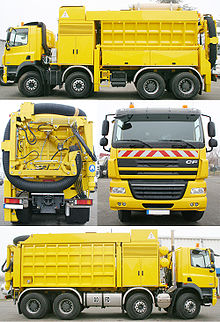Suction excavator
This article has multiple issues. Please help improve it or discuss these issues on the talk page. (Learn how and when to remove these messages)
|

A suction excavator, or vacuum excavator, is a construction vehicle that removes heavy debris or other materials from a hole on land using vacuuming. Suction excavators are meant to be more non-destructive than regular excavators.[1] The suction excavator uses suction fans for the airflow to suck up the material that is then transported into the holding tank.
Hydro excavation, a type of suction excavator using high-pressure water jets, is sometimes referred to as daylighting, as the underground utilities are exposed to daylight during the process.[2] Some suction excavators also use an air filter.
History
[edit]Since 1993, RSP UK Suction Excavators Ltd. has produced suction structures mounted onto two, three, and four-axle vehicles, stationary suction units, and custom-made machines.[3] Pacific Tek,[4] also founded in 1993, has created the Angled Vacuum Excavator Tank (1997) and the 180° Swivel Mount Valve Operator (1999).
In 1998, the Mobile Tiefbau Saugsysteme produced another type of suction excavator.[5]
The global market size for suction excavators was estimated to be valued at US$924.7 million in 2020.[6]
Uses
[edit]Suction excavators are sometimes used for removing earth around buried utilities and tree roots. It can suck up liquids, e.g., water from a hollow. Typically, vacuum excavation loosens the soil with a blunt-nosed high-pressure air lance or water source and vacuums away loosened material.

Depending on the machine used and soil conditions, a 12-inch-square, 5-foot-deep pothole can be completed in 20 minutes or less.[7] Vacuum excavation is sometimes used in conjunction with conventional underground (one-call) locating services. Because of overlapping buried utility lines, locating devices often miss some of the buried utilities on a site and cannot completely or accurately mark a site.
According to New Mexico 811's (NM811) Aligning Change, Locating with Potholing, "One-call paint marks and flags are the first steps in making the process of locating underground utilities safer, the use of vacuum excavation technology adds an additional margin of safety."[8]
See also
[edit]- Dredging
- Gully emptier
- Street sweeper
- Suction dredger, used for dredging underwater
- Suction (medicine)
References
[edit]- ^ 365 vacex (10 July 2023). "Everything You Need to Know About Suction Excavation". Medium. Retrieved 6 June 2024.
{{cite web}}: CS1 maint: numeric names: authors list (link) - ^ "What is Daylighting Excavation?". cloud-9-services. 16 September 2020. Retrieved 6 June 2024.
- ^ "History". RSP-Germany. Retrieved 24 June 2014.
- ^ "pacific-tek.com". pacific-tek.com. Retrieved 16 December 2014.
- ^ "MTS Suction Excavators". Retrieved 24 June 2014.
- ^ Saurabh Vijay, Samel; Mutreja, Sonia (October 2023). "Suction Excavator Market Size, Share, Analysis and Forecast 2023-2032". Allied Market Research. A12455. Retrieved 6 June 2024.
- ^ Griffin, Jeff. Underground Construction. Oildom Publishing, 2001.
- ^ 2009 New Mexico 811 Magazine. Published by ACTS Now, Inc.
External links
[edit]![]() Media related to Suction excavators at Wikimedia Commons
Media related to Suction excavators at Wikimedia Commons
